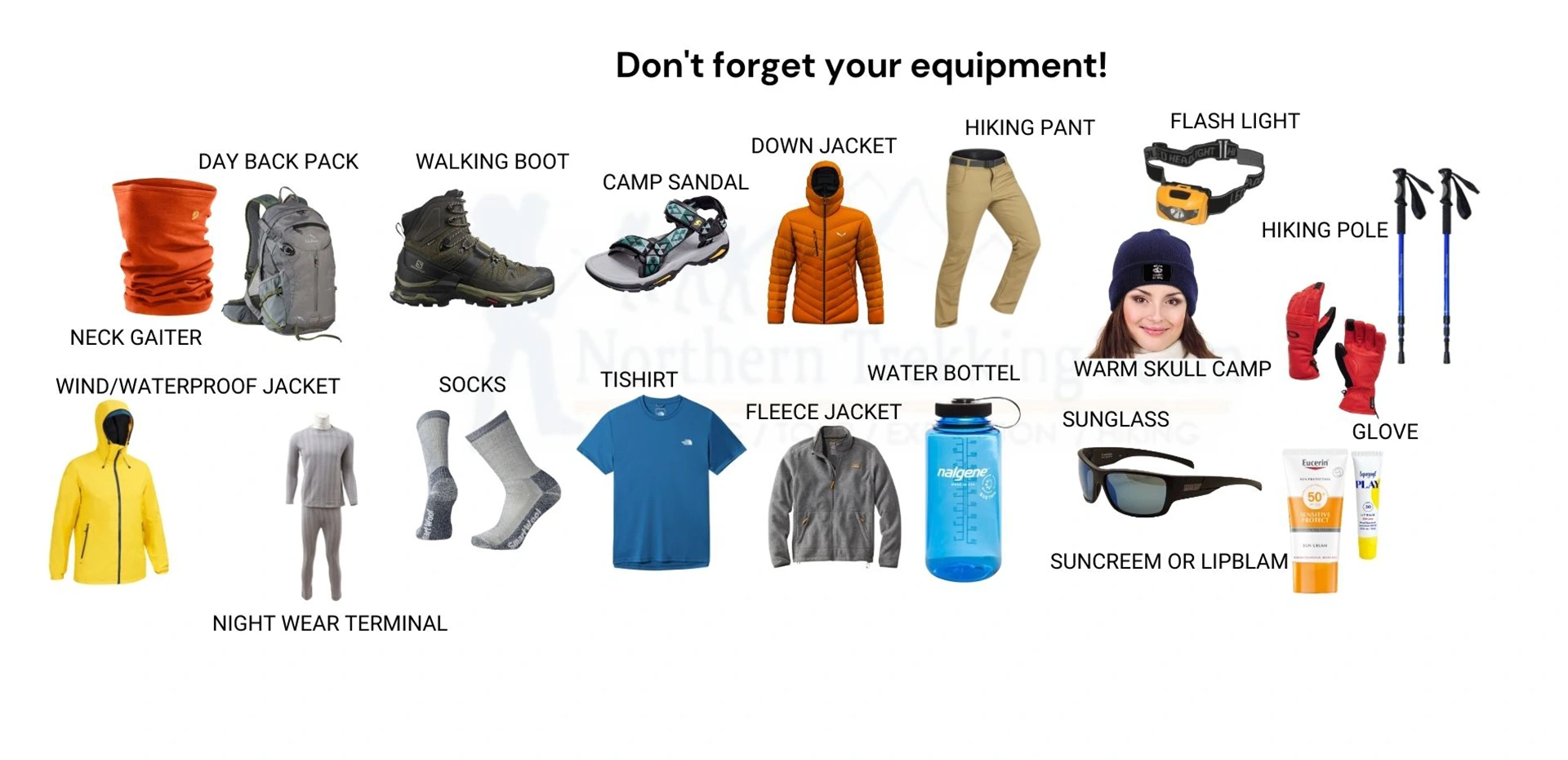Would you like to cross the majestic Himalayas and see the beautiful scenery of Nepal? Many people’s dream is to go climbing in this Himalayan paradise, but they need to make sure they are well-prepared to make sure the trip is safe and fun.
A lot of the most famous trails are “teahouse treks,” which means you’ll stay and eat in small lodges called teahouses. You won’t need a tent, sleeping pad, stove, cooking gear, or any other camping gear for a teahouse trip.
We will walk you through the most important gear and tools you need for your Nepal trekking trip in this detailed Nepal trekking gear checklist.
Sleeping
- A tent is needed for trips where you camp.
- A sleeping bag (a –15° bag will do for most hikes) and a small, light sleeping pad for warmth.
- Mattress for sleeping
Footwear
- Comfortable hiking boots with good grip
- Extra pairs of moisture-wicking socks
Clothing
- Lightweight Trekking Pants:
- Ideal for moderate temperatures and protection against elements like wind and light rain. Quick-drying materials are a plus.
Trekking Shorts
- Great for warmer weather or when you need more flexibility and ventilation during your trek.
T-Shirts (Lightweight Wool)
Lightweight wool is excellent for moisture-wicking and temperature regulation. It’s also odor-resistant, which is beneficial during extended treks.
Underwear
Choose moisture-wicking and quick-drying materials to stay comfortable during your trek.
Long Underwear/Wool Thermals
Essential for colder temperatures. Wool thermals provide good insulation and moisture-wicking properties.
Fleece
Provides insulation and warmth, especially in cooler conditions. Fleece is lightweight and retains heat even when wet.
Waterproof Jacket and Pants
Crucial for protecting against rain, snow, and wind. Look for breathable materials to prevent overheating during physical activities.
Heavyweight pants for high elevations
Necessary for colder and higher-altitude environments. Ensure they are windproof and insulated for added warmth.
Heavy Down Jacket (Rentable in Kathmandu)
Perfect for extreme cold conditions, especially at high elevations. Down jackets provide excellent insulation and are packable.
Winter Hat
A warm hat is essential to retain heat, especially in cold climates. Choose the hat that covers ears for added protection.
Winter Gloves
Insulated, waterproof gloves are crucial for protecting your hands from cold temperatures, wind, and moisture.
Backpack
- Look for backpacks made from durable materials such as ripstop nylon, polyester, or a combination of both with adjustable straps
- Padded shoulder straps and back panels provide comfort during extended wear.
- The rain cover should be made from waterproof materials to keep your belongings dry
Accessories
Trekking Poles
Adjustable trekking poles provide stability and reduce strain on your knees during the trek.
Trekking Map
Ensure you have a detailed topographic map of the trekking area. Waterproof maps are preferable.
Compass and/or GPS device
A compass is essential for navigation, and a GPS device can provide additional accuracy. Consider a reliable GPS device with a long battery life for extended treks.
Water Purification
Choose a water purification method suitable for your trek:
– Water pump/filter
– Water purification tablets
– UV-C light purifier (e.g., SteriPen)
Water Bottles
Bring at least 3 liters of water-carrying capacity. Consider a combination of water bottles and a hydration system, depending on your preference.
Sunglasses
UV-protective sunglasses with good coverage shield your eyes from harsh sunlight and reflections in snow.
Headlamp/Flashlight with Extra Batteries
A reliable headlamp or flashlight is crucial for navigating in low-light conditions. Carry extra batteries or ensure they are fully charged before your trek.
Journal and Pens
A journal can be a great way to document your trekking experiences. Waterproof pens are useful in cases of rain.
Camera with Extra Batteries
Capture memories with a durable and lightweight camera. Make sure that you have extra batteries or a portable charger.
Gaiters (for Winter Trek)
Gaiters are essential for protecting your lower legs and boots from snow, water, and debris during winter treks.
Personal Supplies
Sunscreen
Choose a high-SPF sunscreen to protect your skin from harmful UV rays. Opt for a water-resistant formula and remember to reapply as needed, especially during prolonged exposure.
Hand Sanitizer
An essential item for maintaining hand hygiene in outdoor environments where access to soap and water might be limited. Carry a small, travel-sized bottle.
Toiletries
Pack a travel-sized toothbrush, toothpaste, deodorant, dental floss, and any other personal hygiene items you require. Keep it minimal to save weight and space.
Biodegradable Bar Soap
Choose a biodegradable soap to minimize your environmental impact. This is useful for both personal hygiene and washing dishes if needed.
Face/Body Wipes
Wet wipes are convenient for a quick refresh when access to water is limited. Look for biodegradable or environment-friendly options.
Throat Lozenges, Lip Balm
Throat lozenges can soothe a sore throat, and lip balm with sun protection helps prevent chapped lips, especially in dry or cold conditions.
First Aid Kit
Assemble a basic first aid kit with items such as adhesive bandages, antiseptic wipes, pain relievers, blister treatment, tweezers, and any personal medications you may need. Customize it based on your health needs and the nature of your trek.

Have Question?
Talk to Expert


